Last Updated on April 5, 2024
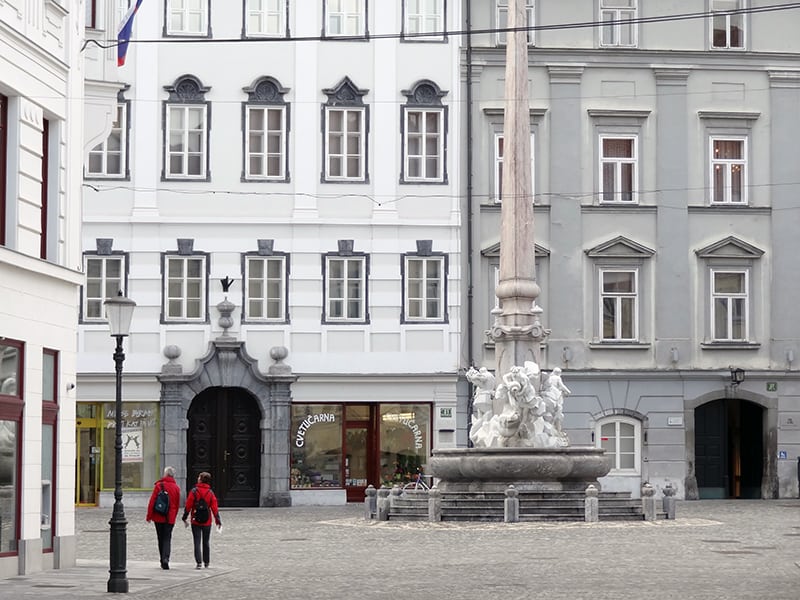
Ljubljana, the capital of Slovenia, is an incredibly beautiful and affordable city that’s too often missed by travelers. What you can’t miss here are all the things to do in Ljubljana, including seeing some beautiful Art Noveau and Baroque architecture…
Estimated reading time: 10 minutes
By Jim Ferri
Perhaps it’s the size of Slovenia’s capital, or lack of it, that causes so many travelers to ignore it. That’s a mistake because it’s not only a beautiful city, there are also many things to do in Ljubljana. And it’s one of the most affordable cities in Europe.
The capital of Slovenia, a country wedged between Northern Italy and Croatia and not even half the size of Switzerland, is easily missed by those in their rush to the beaches of Croatia and Greece.
Unfortunately, these travelers never realize they’ve missed one of the most beautiful and charismatic cities in southeastern Europe. And it’s an easy day trip by train from Trieste in the northern Provence of Friuli Venezia Giulia in Italy.
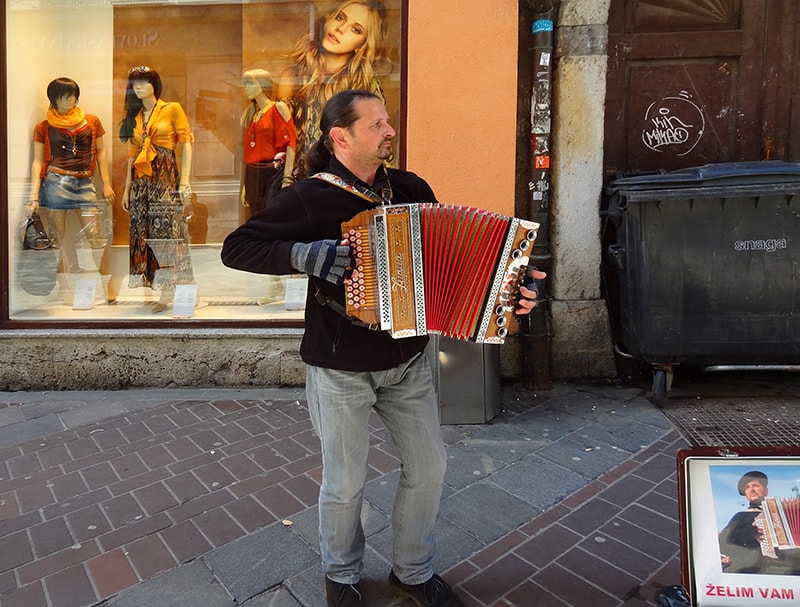
Brimming with Old World Charm
Ljubljana was born centuries ago as a Roman trading center, and finally became the capital of one of the seven nations spawned by the collapse of the former Yugoslavia. It’s fascinating place with a fairytale castle up on a hillside right in the middle of a beautiful Old-World city.
It’s bisected by the Ljubljanica River, which separates the Old Town(Stari Grad) on the east bank and the New City on the west. In Old Town, you find plenty of things to do as you discover its Baroque architecture and old churches. It also has plenty of intriguing little shops and markets, and little-cobbled streets worthy of its Old World character.
In the New City, there are several important museums, including the Modern Gallery and the National Gallery. It’s also the home of Slovenia’s Parliament, and the National and University Library, with its students infusing the area with a youthful feeling.

One of the Things to Do in Ljubljana: Enjoy ‘s Its Quiet Elegance
Seeing both sides of the city is not as daunting as it may sound. That’s because the city is so small it’s easy to visit it on foot, and much of it is traffic-free. That doesn’t always mean you can get someplace quickly, however.

Prešeren Square on the river is a perfect place to start an exploration of both sides of the river. Although it was only a 10-minute walk from my hotel, it took me almost 40 minutes to reach the square. That’s because I found myself absorbed by the beauty of the Art Nouveau architecture along Miklošičeva Street. It seemed as though I stopped on every block to admire something new along the way.
That’s the danger of Ljubljana: it’s so quietly elegant that its beauty silently draws you in.
As you walk its cobblestone streets, about beautiful fountain-studded plazas, and along the streets lined with Baroque, Art Nouveau (some of the best preserved in this area of Europe) and 20th-century architecture, you pause to admire and quickly lose track of time.
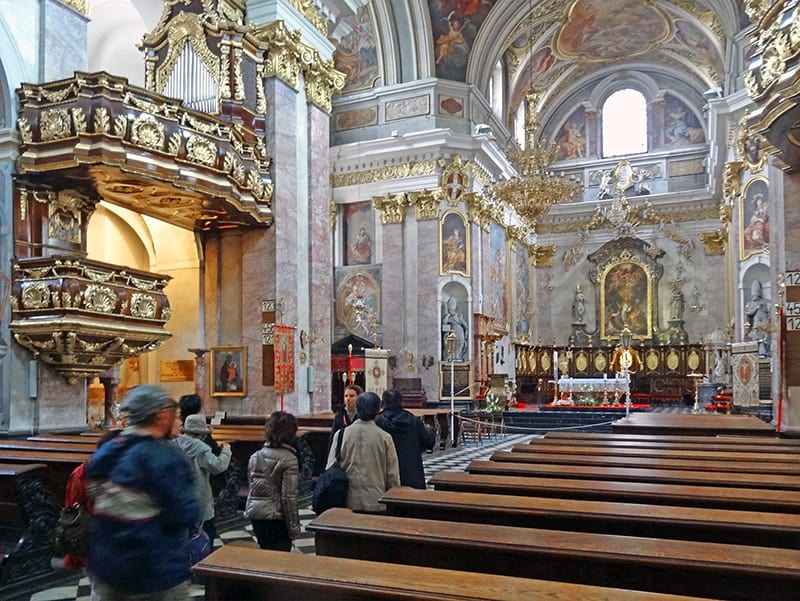
One of the Top Places in Ljubljana: Old Town
At Prešeren Square I crossed the Triple Bridge into the Old Town. From there I headed straight up the street to the beautiful Baroque Robba Fountain of the Three Rivers. It’s beautiful but a replica; the original is in the National Gallery over on the left bank. When I walked along the street near the nearby City Hall, I immediately felt I had stepped into another century.
I walked about a bit, looking at the many cafés and poking my head into several small shops.
Then, drawn by the tolling of bells that reverberated down the cobbled streets. I walked over to St. Nicholas Cathedral, a small, beautiful Baroque cathedral.
Staying for a while, I shared the church with a Japanese tour group. Unfortunately for them, they rushed through, their guide hurrying them in the back door and out the front without stopping. After a few minutes, I followed them out and soon found myself in the middle of the city’s outdoor market.
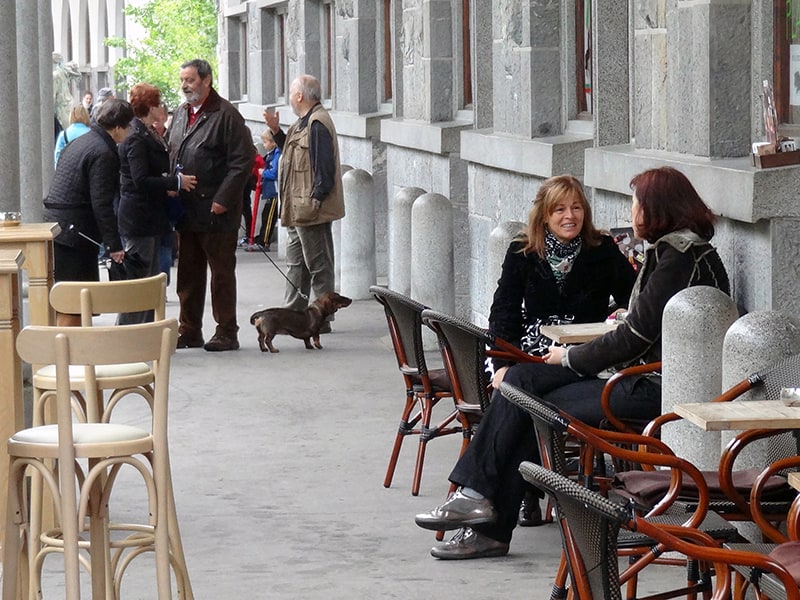
A Popular Place in the City: The Market Colonnade
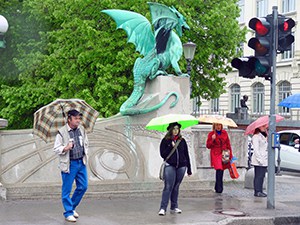
The market was a tidy, little colorful place, filled with vendors selling fruits, vegetables, and clothing. It is squeezed in between the woods running down the hill from Ljubljana Castle above, and the Market Colonnade on the riverbank. The Colonnade is a long, low building of little cafés, cheese and butcher shops, and bakeries. Regardless of the time of day you pass, you always see people at its little tables, sipping coffee or beer.
At one end of the Colonnade, there were a few stands selling little art nouveau glass figurines and other trinkets. A group of Americans stood around their guide near one of them, learning where to meet their bus later in the day.
Nearby is Ljubljana’s famous Dragon Bridge, a dragon sitting atop a pedestal at each end. The symbol of the city, it’s one of its more photographed attractions in the city. It’s also just a three-minute walk from the modern glass funicular that goes up to the castle.
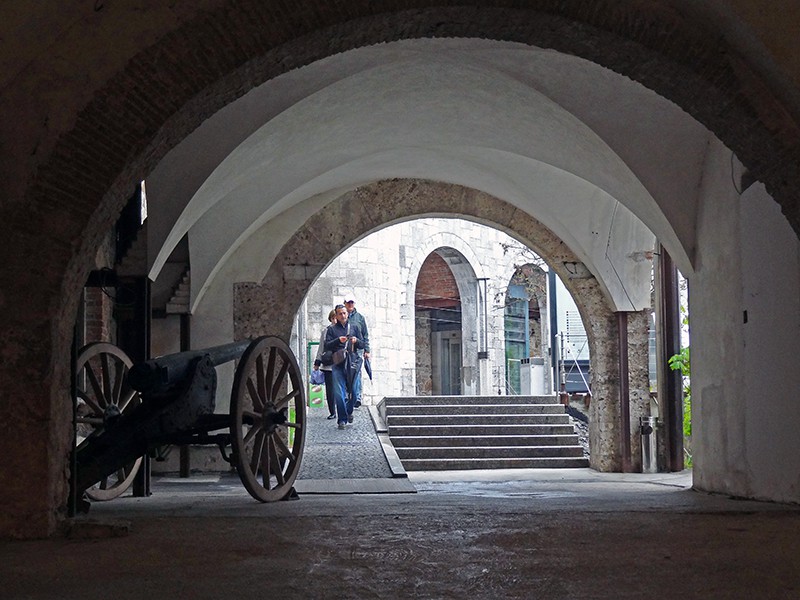
Don’t Miss Ljubljana Castle
I took the funicular up to Ljubljana Castle (€8 per adult, €5 for those over 60) to walk its ramparts. It also provided a great view of the city rooftops with the snow-capped Karavanke Mountains in the distance. Walking around, I mistakenly entered the gift shop thinking it was the entrance to the coffee shop overlooking the courtyard.
It was selling quality local crafts, including scores of good-luck flying witches. All of the handicrafts in the shop were well made. I would have bought a few things if I thought they would fit into my carry-on. I wound up leaving empty-handed.
About an hour later I walked along the road through the forest back down to the Old Town. The rest of the day I spent wandering aimlessly in the city. All of the Old Town, as well as a good-sized area on the left bank, is car-free. It’s open only to pedestrians and bicycles, which helps keep the pollution and noise down. That’s likely one of the reasons the city is so tranquil and clean.
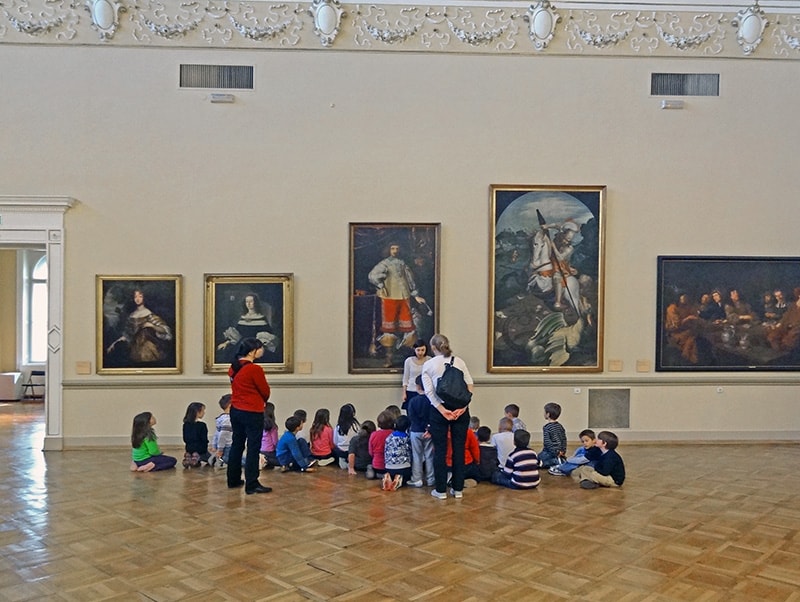
Another of the Things to Do in Ljubljana: See the New City
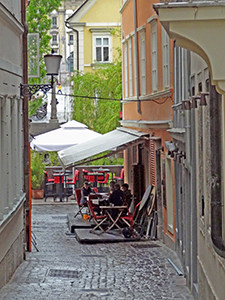
The next morning I returned to Prešeren Square and walked up Copova Street. I was heading for the National Gallery, which, like my hotel, was only about 10 minutes away. Copova, like most of the Old Town, was also a pedestrian zone. I found mix of shops and crowded cafés interesting and kept stopping along the way. Needless to say, I again fell behind my self-imposed schedule as I made many stops along the way.
The National Gallery is in a beautiful and elegant 19th-century building that’s connected to a modern one, where you enter.
The first thing you see in the lobby is the original of Robba’s Fountain of the Three Rivers of Carniola. I thought how glad I was it was rescued from the street. I could see the toll the weather and elements had already begun to take on it before it was rescued.
The museum is filled with small, interesting collections, but most spectacular is the superb interior of the old building itself. Wandering about, I entered one room that was completely dark, with the paintings lit only by small spotlights from the ceiling. The paintings looked as if they were floating in the air.
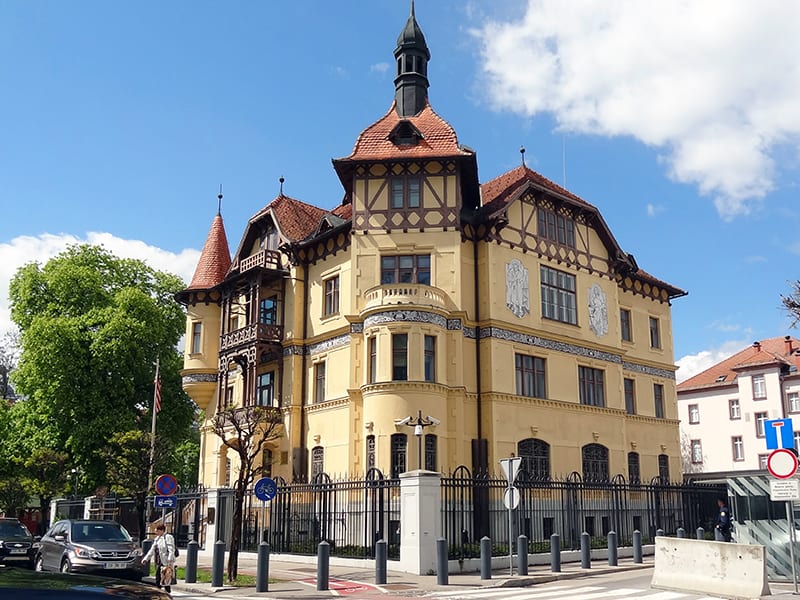
A Beautiful Embassy, A Non-Descript Parliament
Leaving the gallery, I came to the U.S. Embassy right around the corner. It’s in a beautiful, historic late-19th century home, and when I stopped to read a brass plaque on the fence in front, a guard with a camera around his neck approached me.
Without saying a word, he handed me a card with the history of the building printed on it, obviously wanting me to move on. As I continued along the sidewalk, I looked back and saw that another guard had come out to watch where I was going.
When I crossed the street and turned at the next corner, I saw the Maxi Center, a small upscale shopping center near a row of beautiful old buildings. In the courtyard of the buildings was the Parliament Pub, filled with students and others enjoying the warm spring day.
You might also enjoy: Slovenia’s Lipica Stud Farm and Its Beautiful White Lipizzaners / Day-Tours in 5 of the Best Eastern European Cities / Best Places to Visit in Europe – 9 Worth a Detour
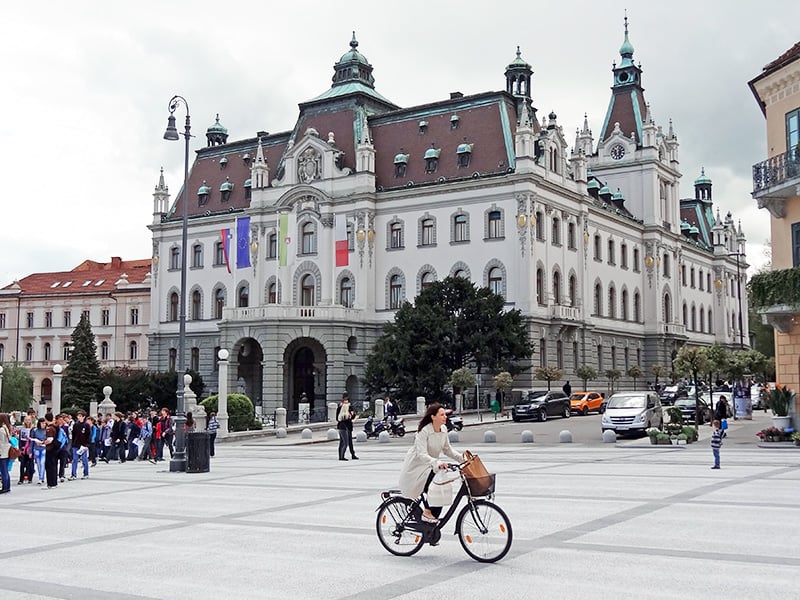
The Showstopper
But the real showstopper, across the street from the Maxi, was the National Assembly and Slovenia’s Parliament building that is so nondescript I almost walked right by it. What caught my eye, though, was the beautiful bronze sculpture at its entrance, showing scores of intertwined figures depicting, as far as I could tell, everyday life in Slovenia.
Further along, I walked through Congress Square where I saw another beautiful old 19th-century mansion, which to my surprise turned out to be the University of Ljubljana. I continued walking back towards Prešeren Square, where I found five street musicians performing near the statue of national poet France Prešeren.
I joined the dozens of people who sat sipping a beer or afternoon coffee outside a nearby a café to watch the performance. For me, and I suspect for those café-loving Slovenians, it was the perfect ending to the day.
The next day I drove to the spectacular Lipizzaner Stud Farm in Lipica, Slovenia, about an hour away, near the Italian border. It also was an incredible trip.
If You Go:
Slovenian Tourist Board
Dimičeva 13
1000 Ljubljana
Slovenia
Tel.: ++386 1 589 85 50
National Gallery
Prešernova 24
1000 Ljubljana
Slovenia
Tel: +386 1 24 15 434

And the people is so much more civil than the hostile Croats
One of the prettiest places I’ve been. Thanks for highlighting it.
Yes it is such a beautiful city, and with very kind people. It’s definitely worth a trip if you’re in northern Italy or Croatia.
You give so many great details on what to see here in Slovenia. Your story is really enjoyable to read. Makes me want to visit this wonderful capital city! Thank you.
We really enjoy your story! What a beautiful area to visit. We hope to go there too after reading your story!
It is a beautiful city, one of those “I can’t believe I’ve missed this before” places that’s quite enjoyable. Go before it gets overrun with tourists!
Hi Helen,
You’re never too old…..
I have a particular fondness for Ljubljana from a night spent there in 1974. Pleasant city manageable even to the ignorant which we were, due to the kindness friendliness and helpfulness of its people. We loved them and we loved Ljubljana. I wish I could go back but I’m too old to make it happen again now.